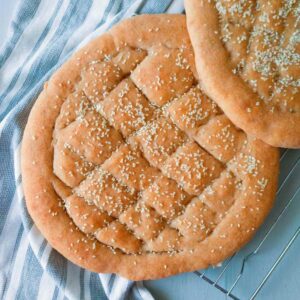
The Best Gluten-Free Turkish Bread
This delicious gluten-free Turkish bread is the softest and fluffiest Turkish bread you will make!
Equipment
- 1 bench scraper (optional)
- 1 digital scale (optional)
- 1 whisk
Ingredients
- 200 grams (a little less than 1 cup) milk use plant-based milk for vegan version
- 160 grams (⅔ cup) water
- 2 tablespoon oil olive or vegetable oil
- 18 grams psyllium husk whole husks, if using coarse powder, use 15 grams, read ‘psyllium husk in baking’ guide for more details.
- 2 teaspoon sugar
- 7 grams dry active/instant yeast or 20 grams of fresh yeast
- 360 grams gluten-free flour I used my homemade millet mix which would be 148g millet flour, 50g sorghum flour, 108g potato or cornstarch, 54g tapioca starch
- 2 teaspoon salt
You Will Also Need
- 1 egg for the egg wash or oil for the vegan version
- sesame seeds for topping
Instructions
Mix the dough
- If your milk and water are cold, warm them up in a microwave until slightly warm, Then, add water, oil, milk, psyllium husk, sugar, and yeast to a medium bowl and whisk to combine. Leave for 1-2 minutes to let psyllium gel form.
- Once the psyllium mixture has thickened into a gel, add it to a large mixing bowl along with the flour and salt. Bring the dough together by hand (you can also use a mixer if you prefer), then scrape the sides to bring the dough into a ball.
- Leave the dough to rise for about an hour. It should rise significantly, if your dough is not rising, that might mean that your yeast is expired or you need more yeast to raise the dough. The effectiveness of the yeast also varies from brand to brand.
Shape the breads
- Start preheating the oven to 350F/175C. Transfer the dough onto a floured piece of parchment paper, dust it with flour, and shape it into a ball. If the dough sticks to your hands, flour it more. Then, press the ball into a 9-10 inch (25-26cm) flat circle with your hands. You can use a rolling pin if you prefer.
- Using your finger, poke the dough in a circle and then diagonally to create the traditional Turkish bread pattern. Finally, brush the bread with oil or an egg wash and top with sesame seeds. Let the dough rest for a few minutes until the oven is done heating. While the first bread is baking, shape the second one.
Bake
- Place a baking dish with water in the bottom of the oven to create extra steam that will allow for a better rise. Bake the bread for 25-30 minutes until lightly brown and the toothpick comes out without much raw dough sticking to it.
- Let the bread cool for 10-15 minutes and enjoy fresh! You can store the bread at room temperature for 2 days, in the refrigerator for 3-4 days, and in the freezer for up to 3 months. Keep the bread covered or in an air-tight container/bag.
Notes
– Don’t add extra flour if you think the dough is too sticky. You will be able to work with it and the dough needs to be this sticky for the soft and fluffy texture.
– Poke the pattern once again after brushing the dough with oil/egg wash to reinforce it.
– Let the bread cool down before eating to let the crumb set.
- Check out the best food to serve Turkish bread with!
Nutrition
Serving: 1breadCalories: 847kcalCarbohydrates: 160gProtein: 14.1gFat: 18.4gSaturated Fat: 4.1gCholesterol: 8mgSodium: 2933mgPotassium: 60mgFiber: 25.7gSugar: 13gCalcium: 123mg
Tried this recipe?Let us know how it was!